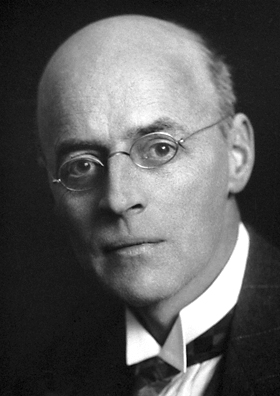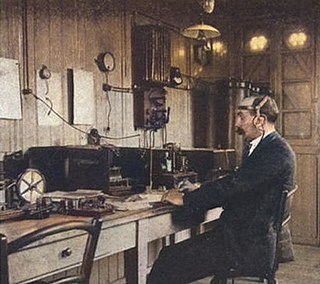Related Research Articles

Guglielmo Giovanni Maria Marconi, 1st Marquis of Marconi was an Italian inventor and electrical engineer, known for his creation of a practical radio wave–based wireless telegraph system. This led to Marconi being credited as the inventor of radio, and he shared the 1909 Nobel Prize in Physics with Karl Ferdinand Braun "in recognition of their contributions to the development of wireless telegraphy".

Sir John Ambrose Fleming FRS was an English electrical engineer and physicist who invented the first thermionic valve or vacuum tube, designed the radio transmitter with which the first transatlantic radio transmission was made, and also established the right-hand rule used in physics.

Karl Ferdinand Braun was a German electrical engineer, inventor, physicist and Nobel laureate in physics. Braun contributed significantly to the development of radio and television technology and built the first semiconductor. He shared the 1909 Nobel Prize in Physics with Guglielmo Marconi "for their contributions to the development of wireless telegraphy", was a founder of Telefunken, one of the pioneering communications and television companies, and has been both called the "father of television", "great grandfather of every semiconductor ever manufactured" and the co-father of the radio telegraphy, together with Marconi.
The year 1900 in science and technology involved some significant events, listed below.
The year 1902 in science and technology involved some significant events, listed below.

The year 1905 in science and technology involved some significant events, particularly in physics, listed below.
The year 1906 in science and technology involved some significant events, listed below.
The year 1909 in science and technology involved some significant events, listed below.
The year 1912 in science and technology involved some significant events, listed below.
The year 1915 involved numerous significant events in science and technology, some of which are listed below.
The year 1918 in science and technology involved some significant events, listed below.
The year 1874 in science and technology involved some significant events, listed below.
The year 1845 in science and technology involved some significant events, listed below.
The year 1868 in science and technology involved some significant events, listed below.
The year 1854 in science and technology involved some significant events, listed below.

Sir Owen Willans Richardson, FRS was a British physicist who won the Nobel Prize in Physics in 1928 for his work on thermionic emission, which led to Richardson's law.
The year 1928 in science and technology involved some significant events, listed below.
The year 1929 in science and technology involved some significant events, listed below.

The invention of radio communication was preceded by many decades of establishing theoretical underpinnings, discovery and experimental investigation of radio waves, and engineering and technical developments related to their transmission and detection. These developments allowed Guglielmo Marconi to turn radio waves into a wireless communication system.
References
- ↑ "The Okapi". Forest and stream. Vol. v.57 (1901). [Forest and Stream Publishing Co.] 1901. Retrieved 2024-02-15.
- ↑ Über die Bindungsstelle der Metalle in ihren Verbindungen und über Dinitritoäthylendiaminkobaltisalze.
- ↑ "DGGMNT". Archived from the original on 2012-03-02. Retrieved 2011-10-10.
- ↑ Comptes rendus de l'Académie des Sciences .
- ↑ Griffin, N. (2004). "The Prehistory of Russell's Paradox". In Link, Godehard (ed.). One Hundred Years of Russell's Paradox: mathematics, logic, philosophy. p. 350. ISBN 978-3-11-017438-0.
- ↑ Parshall, K. H. (1991). "A study in group theory: Leonard Eugene Dickson's Linear groups". Mathematical Intelligencer. 13: 7–11. doi:10.1007/bf03024065.
- ↑ Crilly, Tony (2007). 50 Mathematical Ideas you really need to know. London: Quercus. p. 141. ISBN 978-1-84724-008-8.
- ↑ Stanier, Peter (2010). Cornwall's Industrial Heritage. Chacewater: Twelveheads. p. 14. ISBN 978-0-906294-57-4.
- ↑ Bussey, Gordon (2000). Marconi's Atlantic Leap. Coventry: Marconi. ISBN 0-9538967-0-6.
- ↑ Einstein, A. (1901). "Folgerungen aus den Capillaritätserscheinungen" (PDF). Annalen der Physik . 309 (3): 513–523. Bibcode:1901AnP...309..513E. doi:10.1002/andp.19013090306.
- ↑ Nobel Foundation (1928). "The Nobel Prize in Physics 1928: Owen Willans Richardson". Nobelprize.org. Retrieved 2012-01-17.
- ↑ Beekman, George. "The nearly forgotten scientist Ivan Osipovich Yarkovsky". Journal of the British Astronomical Association . 115 (4): 207–212. Bibcode:2005JBAA..115..207B.
- ↑ "Alois Alzheimer". Whonamedit? . Retrieved 2011-10-21.
- ↑ Takamine, J. (1901). "The isolation of the active principle of the suprarenal gland". The Journal of Physiology. Cambridge University Press. 27: xxix–xxx. doi:10.1113/jphysiol.1902.sp000893. PMC 1403136 . See also American Journal of Pharmacy73 (1901):525.
- ↑ Todes, Daniel Philip (2002). Pavlov's Physiology Factory. Baltimore: Johns Hopkins University Press. pp. 232 et seq. ISBN 0-8018-6690-1.
- ↑ Schollmeyer, Thoralf; et al. (November 2007). "Georg Kelling (1866-1945): the root of modern day minimal invasive surgery. A forgotten legend?". Archives of Gynecology and Obstetrics. 276 (5): 505–9. doi:10.1007/s00404-007-0372-y. PMID 17458553.
- ↑ Porter, Roy (1997). The Greatest Benefit to Mankind: a medical history of humanity from antiquity to the present. London: HarperCollins. p. 474. ISBN 0-00-215173-1.
- ↑ Leishman, W. B. (1903). "On the possibility of the occurrence of trypanomiasis in India". The British Medical Journal .
- ↑ Dittmann, Frank (1991). "Die gleislose Bielatalbahn". Sächsische Heimatblätter (3): 177–180. ISSN 0486-8234.
- ↑ Penguin Pocket On This Day. Penguin Reference Library. 2006. ISBN 0-14-102715-0.
- ↑ "Hornby's 1901 patent" . Retrieved 2010-08-14.
- ↑ US 775134 "Razor"
- ↑ "Patent number 669348: T. Rall movable bridge". United States Patent and Trademark Office (referenced online by Google Patents). 1901. Retrieved April 21, 2013.
- ↑ Clarke, Mike (2009-01-05). "A Brief History of Movable Bridges" . Retrieved 2012-02-09.
- ↑ "Copley Medal | British scientific award". Encyclopædia Britannica. Retrieved 23 July 2020.